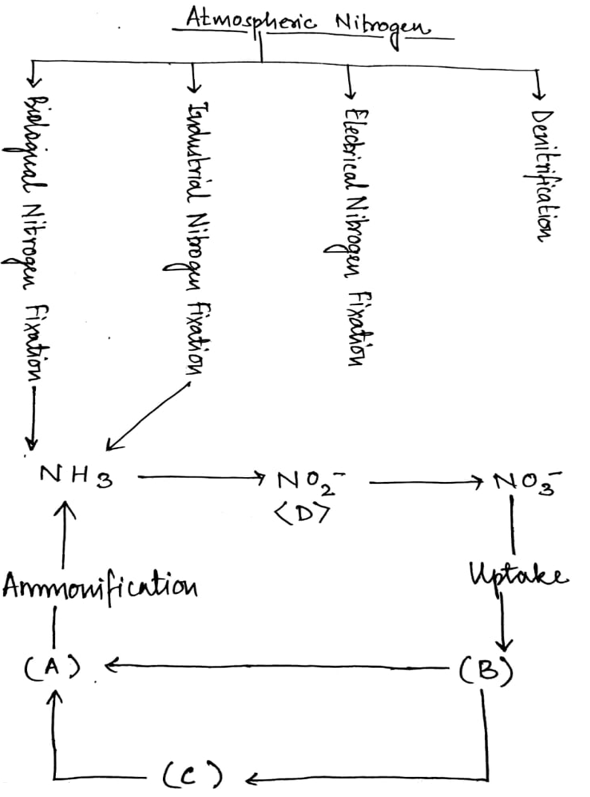This set of Class 11 Biology Chapter 12 Multiple Choice Questions & Answers (MCQs) focuses on “Mechanism of Absorption of Nutrients – 2”.
1. Which of the following is not a pool for nitrogen cycle?
a) Atmosphere
b) Ocean
c) Soil
d) Biomass
View Answer
Explanation: Oceans are not reservoir for nitrogen cycle. They contain nitrogen in form of deposits. Atmosphere, soil and biomass act as pools for nitrogen cycle and there is exchange of nitrogen among them from one form to another.
2. Nitrogen is a limiting nutrient for both agricultural and natural ecosystems.
a) True
b) False
View Answer
Explanation: Nitrogen is a constituent of various substances required by all the living beings. Plants compete with microbes for the uptake of limited nitrogen available in the soil. Nitrogen is a limiting nutrient for both agricultural and natural ecosystems.
3. Statement A: Legume–bacteria relationship is an example of symbiotic biological nitrogen fixation.
Statement B: The association is represented by formation of root knots.
a) Both the statements are true
b) Both the statements are false
c) Statement A is true but Statement B is false
d) Statement B is true but Statement A is false
View Answer
Explanation: The association of bacteria, mostly Rhizobium with the roots of leguminous plants is an example of symbiotic biological nitrogen fixation. Their association leads to formation of pink root nodules.
4. Which is the first stable product of nitrogen fixation?
a) N2
b) NH3
c) NH4+
d) NO3–
View Answer
Explanation: NH3 is the first stable product of nitrogen fixation. N2 is the form in which nitrogen naturally exists. NO3– is the form of nitrogen taken up by the plants. NH4+ is the toxic form of nitrogen which gets accumulated in plants.
5. Which organism is capable of carrying out denitrification?
a) Nitrosomonas
b) Beijernickia
c) Pseudomonas
d) Nitrobacter
View Answer
Explanation: Pseudomonas is the organism is capable of carrying out denitrification. Beijernickia is free-living nitrogen fixing aerobic nitrogen fixer. Nitrobacter convert nitrite to nitrate form. Nitrosomonas convert ammonia to nitrite form.
6. Statement A: Nodule formation involves a direct interaction between Rhizobium and leaves of host plant.
Statement B: The differentiation of cortical and pericycle cells lead to nodule formation.
a) Both the statements are true
b) Both the statements are false
c) Statement A is true but Statement B is false
d) Statement B is true but Statement A is false
View Answer
Explanation: Nodules are pinkish small outgrowths on roots. Nodule formation involves a multiple sequential interaction between Rhizobium and roots of host plant. The division and growth of cortical and pericycle cells lead to nodule formation.
7. Enzymes for nitrogen fixation are found exclusively in eukaryotes.
a) True
b) False
View Answer
Explanation: The enzymes for nitrogen fixation are found exclusively in prokaryotes. Rhizobium bacterium is known for its symbiotic relationship with roots of legumes. Rhodospirillum, Bacillus, Azotobacter are other bacteria having nitrogen fixing capability.
8. The form of nitrogen absorbed by plants is _________
a) NO2–
b) N2O
c) NH3
d) NO
View Answer
Explanation: Plants absorb nitrogen in form of NO2– and NO3–. N2O and NO are obtained from electrical N2 fixation. NH3 is the first stable product.
9. The process under which nitrogen and hydrogen combine to form ammonia under high temperature and pressure conditions is called as _________
a) biological N2 fixation
b) natural N2 fixation
c) electrical N2 fixation
d) industrial N2 fixation
View Answer
Explanation: In industrial N2 fixation, nitrogen and hydrogen combine to form ammonia under high temperature and pressure conditions. Electrical N2 fixation is carried out by lightening process. Biological N2 fixation is taken up by certain prokaryotic bacteria. Natural N2 fixation is not known yet.
10. In the figure given below, (C) represents __________

a) Decaying biomass
b) Plant Biomass
c) Animal Biomass
d) Soil ‘N’ Pool
View Answer
Explanation: A represents the decaying biomass. B represents plant biomass. C represents animal biomass. D represents soil ‘N’ pool.
Sanfoundry Global Education & Learning Series – Biology – Class 11.
To practice all chapters and topics of class 11 Biology, here is complete set of 1000+ Multiple Choice Questions and Answers.
If you find a mistake in question / option / answer, kindly take a screenshot and email to [email protected]
- Check Class 11 - Books
- Practice Class 11 - Mathematics MCQs
- Practice Class 11 - Physics MCQs
- Practice Class 12 - Biology MCQs
- Practice Class 11 - Chemistry MCQs
